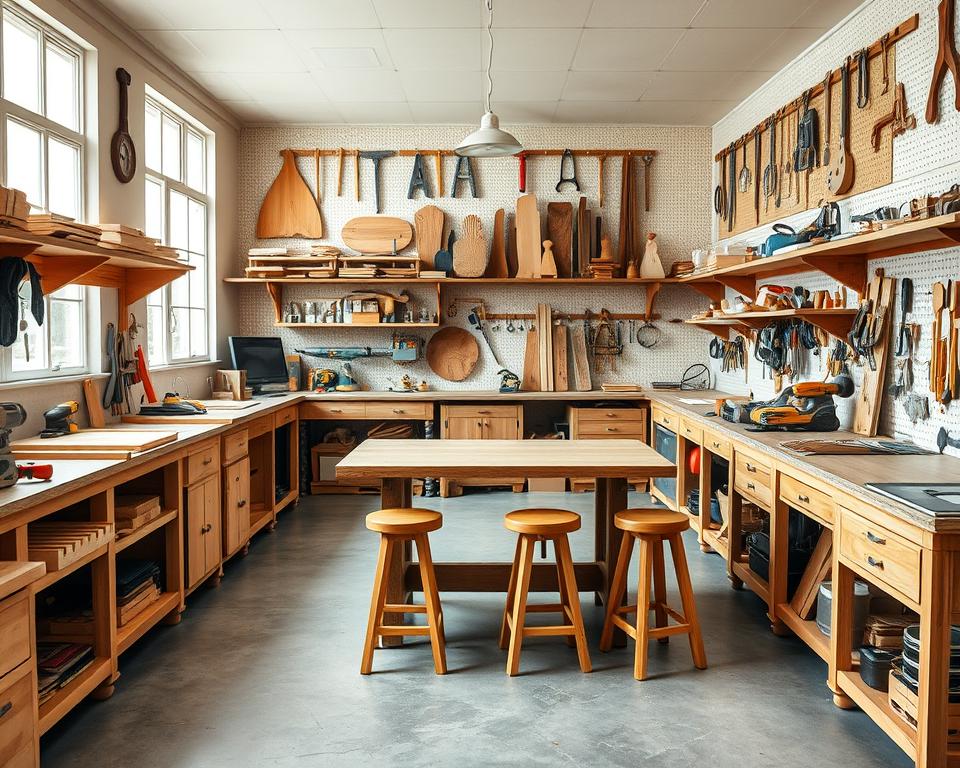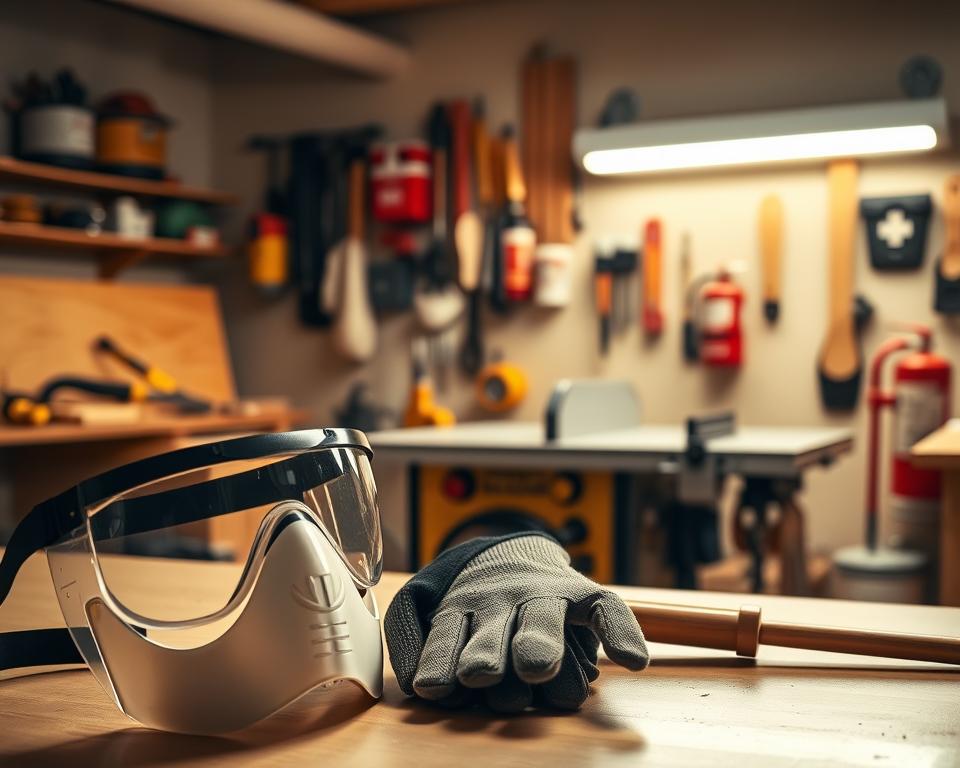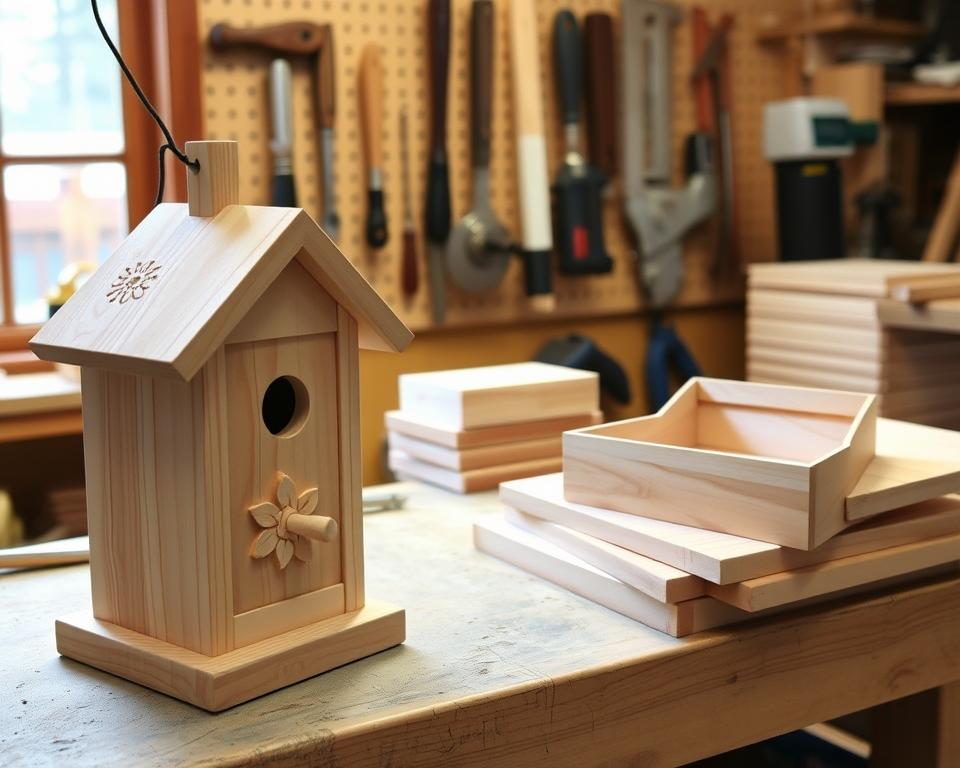Did you know that *woodworking is one of the most popular hobbies, with over 10 million enthusiasts in the United States alone*? This craft lets you show your creativity and learn skills that last forever. If you’re new to woodworking, you’re in the right place! You don’t need a lot of tools to start.
You can make beautiful crafts with just three tools: a drill, a sander, and a circular saw. Learning about these tools makes it easier to start on simple projects. These projects will spark your interest in woodworking and help you grow your skills.
Why Wood Crafts Are Perfect for Beginners
Woodworking is a great way for beginners to start with hands-on projects. It offers many benefits, like learning new skills and feeling proud of your work. DIY wood crafts mix creativity with practical skills, making them fun and rewarding.
Benefits of Woodworking for Beginners
Woodworking has many benefits. It improves your precision and coordination. Every cut and measurement helps you get better at woodworking basics.
It also boosts your analytical skills, helping you solve problems in your designs. Finishing a project gives you a sense of pride. This motivates you to keep exploring your hobby.
Creative Expression Through Wood Crafts
Wood crafts let you express your creativity in many ways. You can try different designs, colors, and techniques. This makes each project special and unique.
Whether it’s a simple birdhouse or a complex piece, you can add your personal touch. This creativity can also help you make friends in woodworking communities. You’ll share ideas and learn from others.
Essential Tools You Need to Get Started
Starting with woodworking basics requires the right tools. The right tools improve your safety and work efficiency. This lets you focus on improving your skills. Here are the three essential tools for beginners.
Overview of the Three Must-Have Tools
Woodworking starts with these key items:
- Drill and Impact Driver Kit: A versatile tool for many tasks, it’s key for holes and screws.
- Cordless Random Orbit Sander: It smooths surfaces well, saving time and effort.
- Circular Saw: Great for straight cuts, it works with various wood types for different projects.
If you’re into carving, you might want specialized tools. For more on carving tools, see this guide on essential carving tools.
Safety Equipment to Consider
Safety is crucial in woodworking. Key safety items include:
- Safety Goggles: Protect your eyes from sawdust and debris.
- Work Gloves: Keep your hands safe from cuts and blisters.
- Dust Masks: Protect your lungs from harmful wood dust.
Start your woodworking journey with these tools and safety gear. The right tools and safety equipment are the foundation for fun and productive projects.
Choosing the Right Wood for Your Project
Choosing the right wood is key in woodworking. For beginners, knowing the different types of wood is crucial. Each wood has its own traits, making some better for certain projects. Exploring these options helps you make better choices in your woodworking.
Different Types of Wood for Beginners
When starting with wood crafts, knowing the best woods is helpful. Here’s a quick guide:
- Pine: Affordable and easy to work with, pine is popular among beginners.
- Cedar: Known for its aroma and natural resistance to decay, cedar is ideal for outdoor projects.
- Spruce: Light and stable, spruce offers excellent sound properties, which also makes it suitable for musical instruments.
- Oak: A sturdy hardwood, oak is more challenging to work with but yields beautiful results for furniture.
- Maple: Known for its density and resistance to wear, maple is perfect for durable and intricate designs.
How to Select Quality Wood
Choosing quality wood is vital for your projects. Here are some tips:
- Inspect for uniformity: Choose wood with consistent color and grain throughout.
- Check for defects: Avoid wood with knots, cracks, or warping that may compromise your project.
- Visit local suppliers: Establishing relationships with local wood suppliers can lead to better quality sources.
- Research reputable lumberyards: They often provide certified woods that ensure quality and sustainability.
Basic Woodworking Techniques to Master
Learning essential woodworking techniques is key for beginners. Whether you want to start with simple projects or aim for more complex ones, a solid foundation is crucial. Knowing some basic techniques will make your woodworking journey smoother and more confident.
Essential Cutting Techniques
Start by improving your cutting skills. Practice making straight cuts with your circular saw. This is a fundamental skill for beginners. As you get better, use your drill to secure joints and parts, which is vital for your projects’ stability.
Understanding Joinery Basics
Then, explore joinery techniques. Learning about different joints, like butt, lap, and pocket hole joints, will greatly improve your projects. These methods not only hold wood pieces together but also make your projects look better. With practice, you’ll be able to create sturdy and attractive items.
Simple Wood Craft Projects to Try First
Starting with simple woodworking projects boosts your confidence. It helps you get used to the tools and techniques. Easy projects like picture frames or small stools are great for beginners. They let you improve your skills while having fun.
Building a basic birdhouse is a fun and educational project. It’s a great way to learn while enjoying the process.
Easy Projects for Beginners
Here are some easy wood projects for beginners:
- Picture Frames – Perfect for displaying your favorite memories.
- Small Stools – A practical addition to any room.
- Birdhouses – A charming way to attract wildlife to your garden.
How to Build a Basic Birdhouse
Building a birdhouse teaches you important skills. First, gather materials like untreated wood, screws, and non-toxic wood glue. Follow these simple steps:
- Measure and cut your wood pieces according to the birdhouse dimensions.
- Assemble the walls and base using wood screws and glue.
- Add the roof, ensuring it has an overhang to protect the entrance from rain.
- Drill a hole for the entrance and a few ventilation points.
- Finish by sanding rough edges and applying a safe, weather-resistant sealant.
Completing this basic birdhouse teaches you essential skills. It’s a rewarding experience that celebrates nature. Each project is a step towards mastering more complex woodworking, improving your craftsmanship and creativity.
Setting Up Your Woodworking Space
Having a dedicated woodworking area makes crafting better. A tidy space helps you focus and work faster. Make sure it’s safe and easy to use.
Creating a Safe and Efficient Workspace
Your workspace should have good air flow and light. A solid workbench is key for a stable place to work. Keep safety gear like goggles and gloves nearby.
This setup keeps you safe and helps you stay focused on your work.
Organizing Your Tools and Materials
Organizing your tools and materials makes projects easier. Use pegboards, shelves, and toolboxes to keep things tidy. A neat space helps you find what you need fast and work better.
Make it a habit to clean up your space often. This keeps your workspace inviting and sparks creativity.

| Organization Method | Description | Benefits |
|---|---|---|
| Pegboards | Attach tools with hooks for easy access. | Quick tool retrieval and visibility. |
| Shelves | Store materials and larger tools. | Maximize vertical space and organization. |
| Toolboxes | Portable storage for essential tools. | Easy transport and protection of tools. |
Tips for Staying Motivated in Your Woodworking Journey
Starting your woodworking journey can be very rewarding. Yet, you might face challenges along the way. To keep your excitement for woodworking, it’s key to stay motivated. Here are two ways to help you stay on track and enjoy reaching your woodworking goals.
Setting Realistic Goals
When you begin woodworking, setting achievable goals is important. Pick projects that fit your skill level and can be done in a reasonable time. Break down big projects into smaller steps to guide you.
Reaching these smaller goals makes you feel accomplished. This boosts your motivation and makes your woodworking experience better.
Tracking Your Progress
Keeping a record of your woodworking journey helps a lot. Try keeping a journal of your projects, tools, techniques, and challenges. This lets you see how far you’ve come and grow.
Sharing your wins and struggles with other woodworkers can also help. It adds support and encouragement to your journey.
Common Mistakes to Avoid as a Beginner
Starting your woodworking journey is exciting. But, it’s key to know common mistakes to avoid. Many beginners think they’re more skilled than they are. This can lead to frustration and accidents.
Always put woodworking safety first. This way, you can enjoy your projects without worry.
Overestimating Your Skills
When you start with wood crafts, you might feel very confident. But, taking on too much too soon can be a letdown. Start with simple projects and learn as you go.
Building a strong foundation is important. This way, you can handle harder projects later without feeling disappointed. Remember, learning takes time, so be patient.
Skipping Safety Measures
Not following safety rules can harm your work and your health. Always wear gloves and eye protection. A well-ventilated area is key to avoid breathing in wood dust.
Sharp tools make your work safer and easier. If you make a mistake, fix it right away. For example, if you splinter wood, stop and use glue and sand for a smooth finish.
| Mistake | Consequence | Prevention |
|---|---|---|
| Overestimating skills | Frustration and dissatisfaction | Start with simple projects, gradually increase complexity |
| Skipping safety measures | Injury or accidents | Always use protective gear and work in a safe environment |
By knowing these mistakes and focusing on safety, you can enjoy woodworking. For tips on fixing mistakes, check out this resource.

Resources for Further Learning and Inspiration
Expanding your woodworking knowledge is key to growing in this craft. You can improve your skills and creativity by exploring top woodworking resources. Start with inspirational woodworking books that give you foundational knowledge, tips, and project ideas.
Books like Aldren A. Watson’s “Hand Tools” and Robert Wearing’s “The Essential Woodworker” are great. They will deepen your understanding and love for woodworking techniques.
Recommended Books and Online Courses
Online courses are also a great way to learn. Sites like Udemy and Skillshare offer woodworking courses for all skill levels. You can learn at your own pace with video lessons, downloadable resources, and forums for discussion.
Community and Local Workshops in Canada
Joining community and local woodworking workshops is very beneficial. These hands-on experiences let you meet seasoned woodworkers and improve your skills in a supportive setting. Many Canadian cities have workshops where you can learn from experts, meet other woodworkers, and get insights into your favorite projects.
Being part of these communities boosts your skills and inspires your next project.




